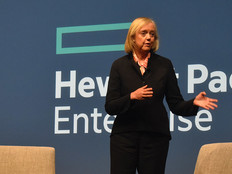HPE Discover 2017: HPE Makes Operational Technology Software-Defined to Help Analyze IoT Data
The worlds of IT and operational technology are sometimes separate, but these days they often converge. Internet of Things data from connected devices is often collected by OT systems; for businesses to make the most of that data, they need to analyze it in real time.
Hewlett Packard Enterprise is aiming to help businesses analyze data more efficiently by introducing what it calls “Software Defined OT.” The new software product makes HPE’s open, x86 Edgeline Systems and OT functions software-defined.
The goal is to make it easier for businesses to analyze data, including IoT data, at the network edge — the world beyond a company’s data center, close to end users.
Collecting OT Data from Connected Devices
Operational technology, Gartner notes, “is hardware and software that detects or causes a change through the direct monitoring and/or control of physical devices, processes and events in the enterprise.”
“We’re on the front lines powering the intelligent edge as your enterprise stretches from deeply connected digital workplaces to intelligently monitored operations to transformative experiences for your customers,” HPE CEO Meg Whitman said at the HPE Discover 2017 conference in Las Vegas this week.
“We’re getting more and more data at the edge, so that data doesn't have to travel back and forth to the data center or to the cloud, and the reality is that often data has to be captured and analyzed at the edge, reducing latency,” Whitman added.
In a company blog post, Ron Neyland, HPE’s senior director of software and solutions, and Tom Bradicich, HPE’s vice president and general manager of servers, converged edge and IoT systems, take a deep dive into HPE’s vision for merging IT and OT.
They note that a main source of OT data comes from connected devices “and is related to OT functions such as control systems, direct wired data acquisition systems, and industrial networks. This convergence of OT and IT is driving new products and services that optimize business operations, address engineering challenges, and accelerate scientific discovery.”
Even as IT and OT converge, Neyland and Bradicich note that “you can’t act on the data you can’t analyze, you can’t analyze data you don’t collect, and you can’t collect what you don’t measure.”
HPE refers to the steps of this data collection process as the 3 As: acquire, analyze and act. “One of HPE’s strategic missions is to help customers acquire, analyze, and act on the data across their operations,” Neyland and Bradicich write. “This data can come from the far extremes of their operational universe, the Intelligent Edge, or from their data centers and clouds.”
HPE’s New Software-Defined OT Platform
About a year ago, HPE launched its Edgeline Converged Edge Systems, which help integrate both OT and IT. Via that solution, OT controls, data capture and industrial network systems are combined with computing, storage, remote systems management, all in one box. That gives businesses a “smaller footprint, fewer items to buy, deploy, and manage, lower energy, and higher reliability,” Neyland and Bradicich note.
The new software-defined OT solution includes several elements. The key piece is HPE Edgeline Services Platform, which serves as the foundational software upon which HPE and its partners deliver applications and services that enable HPE to implement IoT solutions. The goal is to have those IoT operations run at the edge — in factories, refineries, vehicles and end-user devices.
The solution also includes the HPE Edgeline Data Aggregation App, an OT app that ingests and combines data from multiple existing or new OT devices (such as programmable logic controllers (PLCs) and supervisory control and data acquisition (SCADA) systems) and aggregates it in a single data collection.
Further, the platform includes the HPE Edgeline Address Translation App, which converges the task of network address translations from a larger network (for instance, within an entire factory) to one or more subset networks (such as a specific manufacturing line in a factory). That app uses a software-defined configuration to control its activities, which means it can be easily managed and orchestrated remotely, note Neyland and Bradicich.
Using HPE's Intelligent Edge Tech in the Real World
HPE highlights a case study of how this kind of technology can work. The company worked with Texmark Chemicals, a family-owned chemical processing plant in Galena Park, Texas, to create a “refinery of the future.”
“By creating a more connected and automated refinery, Texmark is gaining new analytic insights into areas such as asset tracking and lifecycle management, predictive maintenance, worker safety, video analytics and more,” says JR Fuller, HPE’s worldwide business development manager for IoT Edgeline.
Texmark’s refinery, like many other refineries, is a harsh environment that requires specialized equipment to avoid chemicals or gases from interacting with electrical machinery that could spark.
“This potentially lethal combination makes installing basic technology nearly impossible,” Fuller wrote. “In Texmark’s case, the plant had been running the same low-level communications protocols for more than 40 years because the alternatives required an unacceptably high level of power and risk.”
HPE helped by installing an Aruba instant wireless access point in a heavy-duty box designed for deployment in hazardous conditions, allowing it to implement Wi-Fi in the plant. That made it possible to deploy Aruba Bluetooth Low Energy beacons and Meridian location-based software, which in turn enabled services within the refinery such as indoor-outdoor wayfinding and location-based services and content. Texmark can use data from those services, Fuller notes, to automate processes and help ensure workers are operating in a safe environment.
Edge computing, processing data at the edge, allows companies to “respond more rapidly to anomalies,” Fuller notes.
“Before the advent of edge computing, analyzing video sensor data from industrial sites wasn’t economically feasible, since it required sending extremely large video files to remote data centers for processing,” Fuller notes. “By installing HPE Edgeline EL4000 converged edge systems onsite, Texmark can perform near-real-time advanced video analytics on the video as it is streaming.”
Read articles from BizTech coverage of HPE Discover 2017 here.








